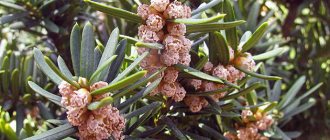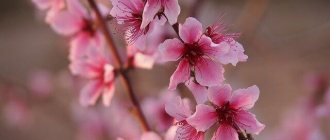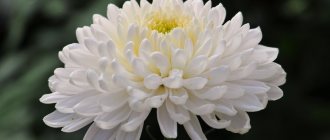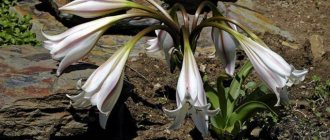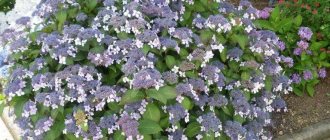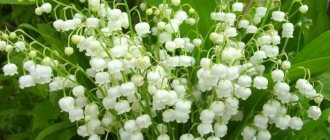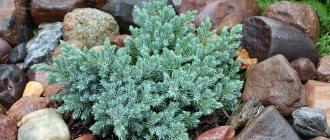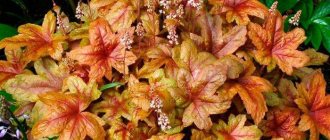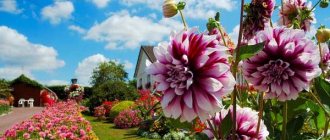Officially, this plant is called “callicarpa” (the name consists of two Greek words kallos and carpos, which translated mean “beauty” and “fruit”). And I must say, it fully lives up to its name, because the berry-shaped drupes, painted in bright purple tones, are really very beautiful. They decorate the bush throughout the entire autumn-winter period and look quite appetizing. However, you should not try them: raw fruits are not only bitter in taste, but also poisonous, especially if consumed in large quantities.
Perhaps the best “decorator” is rightfully considered the beautiful fruit Bodinier 'Profusion' , which was bred at the end of the 19th century. in Holland. “Abundance” is exactly how its name is translated. The height of the plant reaches 2–3 m, the shrub is hardy and bears unusually abundant fruit even at a young age.
Ads by
Description of the beautiful fruit
Beautyberry or Callicarpa (Beautyberry) is a deciduous or evergreen (in tropical climates) shrub or small trees of the Verbenaceae family.
It grows wild in Southeast Asia (where most species grow), Japan, Australia, Madagascar, southern North America and South America. The height of beautiful fruits, depending on the species, ranges from 1.5 to 3.5 meters.
The leaves are opposite, long elliptical, pointed, 5-25 centimeters long.
Inflorescences appear in large numbers and look very beautiful on the plant. The skeletal roots are thick, cord-like, deeply penetrating, poorly branched, and sensitive.
The fruits are bright purple-violet berries that appear in September-October and last a very long time. Because of this feature, the beautiful fruit is sometimes called the “Pearl Bush”.
We advise you to carefully choose the Krasivoplodnik variety, since some species and varieties are quite heat-loving and do not tolerate frosts in the middle zone, although you may find erroneous information on the Internet. Below, we have indicated frost resistance for the most common types.
Beautiful fruit bodiniera bush. © H. Zell
Biological description
This plant came to us from Southeast Asia (most species), as well as Japan, Madagascar, South and North America.
In countries with warm climates these are evergreen bushes, less often trees. Ours is a deciduous perennial crop.
The plant grows up to 1.5 - 3.5 meters.
The leaves on the branches are attached oppositely. They are green, elongated, with a sharp tip.
The roots of the plant are slightly branched, deep, thick. They are quite sensitive.
Callicarpa blooms in August. There are many inflorescences, they are of a dim shade (depending on the variety, the flowers can be light purple, lilac, pink, whitish).
Fruits (aka berries) are formed from September to October. Due to the fact that they do not dry out and are of little interest to birds, these berries can stay on the branches all winter.
An important point: the berries of most varieties can be tasted. But there are also poisonous varieties of beautiful fruit!
Botanical description and homeland of the plant
Beautyberry or Callicarpa is an evergreen or deciduous (in cool climates) shrub, a small tree of the Verbenaceae family. The height of the plant, depending on the type, is in the range of 1.5-3.5 m. Thin shoots spread out in different directions like a fountain. Whole leaves with a sharp apex are 5-25 cm long, arranged oppositely and the distance between pairs is small. With the arrival of autumn, the rich green color gives way to golden, and a pinkish tint often appears.
The root system penetrates deep, has little branching, and is sensitive. The skeletal roots are cord-like and thick.
The natural habitats of the beautiful fruit are warm countries. Most of the species live in Southeast Asia, others can be found in South and North America, Australia, Japan, and Madagascar.
Callicarpa looks harmonious and stunning all season long, but for now the areas are dominated by more famous ornamental shrubs. Gardeners in Russia are just beginning to discover the beautiful fruit.
Flowering and fruiting
Flowering flowering photo
From the name it is clear that the main advantage is the decorative fruits. The round, purple-violet berries are collected in bunches, ripen in the fall and remain on the bush until spring. They are preceded by pretty flowers of a white or pinkish hue with long stamens. The bush blooms in June-July or August, depending on the variety. Purple berries attract with bright colors with glossy tints, which is why the beautiful fruit is often called the pearl bush.
Are the fruits of the beautiful fruit edible? Conventionally: a handful of berries will not cause harm. But remember the warning: you should not eat a lot of raw berries, you may get poisoned.
Winter hardiness of the beautiful carp
Be careful when choosing a beautiful fruit variety, because some representatives cannot tolerate the frosty winters of the middle zone. The most popular variety is ° without additional shelter (winter hardiness zone 5). This means that in the Moscow region and the middle zone you should cover the bushes: hill up the trunk circle for the winter, mulch with a good layer of leaves, and tie the branches of young seedlings and cover them with spunbond. Heat-loving varieties are successfully grown as a tub plant and transferred to a cool room for wintering.
Possible difficulties
The beautiful carp looks more impressive in a group than as a tapeworm. But it is important to provide each plant with sufficient space. “Crowding” results in slow growth, weakened flowering and fruiting, and reduced winter hardiness.
If, despite the efforts of the owners, the branches of Krasivoplodnik are frozen, all damaged shoots must be cut off in early spring. In most cases, the plant recovers.
Young plants need to be “wrapped up” for the winter, even in regions with a warm climate.
Otherwise, the roots may freeze and the plant will die. Editorial team LePlants.ru
Main types of beautiful fruit
The genus Callicarpa includes about 170 species, we list the main ones:
American beautyberry
American buttercup (Callicarpa americana) is native to the southeastern United States. American rosemary is also common in Mexico, Bermuda, the Bahamas and Cuba. Plants of this species are usually from 1.2 to 1.8 meters in height.
American beautyweed. ©John Murphy
The berries are sweet, but when raw they are suitable for consumption in small quantities due to their astringent effect. Jam is made from ripe berries of this species in America. Birds and deer feed on the berries of the American beautiful fruit. Tinctures and teas are made from the roots. The leaves of the American plant help as an organic mosquito repellent.
blooms from mid-spring to mid-summer. The flowers are pale pink, purple, lavender, and white. Attracts bees, butterflies and birds.
Lighting : American beautiful fruit prefers sunny places and partial shade.
Frost resistance of American beautiful fruit from climatic Zone 6 (from -23° to -18°). Let us recall that the territories of central Russia approximately correspond to zone No. 5 from (-29° to -23°).
Soil acidity (pH): From 5.6 (acidic) to 7.5 (neutral)
Inflorescences of Americus americana. © Bob Peterson
Bodiniere's beautiful fruit
Bodinier's beautiful fruit (Callicarpa bodinieri) is native to western and central China (Sichuan, Hubei, Shaanxi) and is more frost-hardy than American beautiful fruit and species cultivated in northwestern Europe. The height of the beautiful bodiniera is from 1.8 to 2.4 meters.
Bodiniere's beautiful fruit bush
The species is named after the 19th century French missionary and botanist who studied plants in China.
Leaves are dark green, red in autumn. In midsummer, small lilac flowers bloom in the axils of the leaves. The berries are not poisonous, but very bitter.
flower blooms in mid-summer. The flowers are purple, lavender.
Lighting : the beautiful bodiniere prefers only sunny places.
Watering : Requires moderate watering, does not tolerate waterlogging.
This species is more tolerant of cold weather than the American beautifulcarp.
The frost resistance of the beautiful fruit bodiniera is from climatic Zone 5 (from -29° to -23°), which means that it can be grown in the Moscow region and the middle zone with shelter.
Soil acidity (pH): From 5.6 (acidic) to 7.5 (neutral).
Bodiniere 'Profusion' has received the Royal Horticultural Society's Award for Achievement in Horticulture.
Branch of beautiful fruit Bodiniere variety 'Profusion'. © Jean-Pol GRANDMONT
Japonica japonica
Japanese sweetberry (Callicarpa japonica) grows in Japan, China, Korea and Taiwan. There it is cultivated as an ornamental and is very popular in gardens and parks. In Japan it is called Murasakishikibu in honor of Murasaki Shikibu, a Japanese poet and writer who lived in the 10th century.
Japanese beautiful fruit bush
Japanese krasnocarp is a shrub with a height of 1.2 to 2.4 meters.
blooms in mid-summer. Flowers are fuchsia (purple).
Lighting : Japanese beautiful fruit prefers partial shade.
Watering : requires constant watering, does not tolerate drought.
This species is less frost-hardy than other species.
Frost resistance of Japanese beautiful fruit from climatic Zone 8 (from -12 to -7°).
Soil acidity (pH): From 5.6 (acidic) to 7.8 (medium alkaline).
Inflorescences of Japanese beautiful carp. © TANAKA Juuyoh
Forkwort
Callicarpa dichotoma (Callicarpa dichotoma) (also called Violet flower) grows in China, Vietnam, Korea and Japan. The height of the shrub is from 90 cm to 1.2 meters. The berries are bitter and unsuitable for culinary use.
Branch of the forked flower. © 영철이
The beautiful forked flower blooms The flowers are pale pink.
Lighting : prefers sun and partial shade.
Watering : Requires moderate watering, does not tolerate waterlogging.
The frost resistance of the forkfruit is from climatic Zone 5 (from -29° to -23°), which means that it can be grown in the Moscow region and the middle zone with shelter.
Soil acidity (pH): From 5.6 (acidic) to 7.5 (neutral).
Inflorescences of the beautiful fruit fork. © KENPEI
Planting and caring for beautiful fruit in open ground
Planting dates: spring and autumn
Beautiful fruit seedling photo
The bush can be planted in a sunny area or in light partial shade. Autumn planting allows the bushes to take root well before wintering and is more preferable. You need to plant bushes in the fall 1-2 months before the onset of night frosts. In the Moscow region, it can be planted at the end of August-September, after the end of the hot summer; in the middle zone, planting is carried out in September-October.
When planting in spring, regular watering of the bush will be required until it is completely rooted. Mulching the tree trunk circle with a layer of mowed grass at least 5 cm will help reduce the frequency of watering and make it easier for the plant to survive.
How to plant
- Having selected a place for planting, we make a hole slightly larger than the seedling’s earthen ball.
- The soil must be moderately fertile, loose, permeable to water and air.
- We pour drainage from coarse sand at the bottom, place the seedling in the center and fill it with soil and water it.
- The root collar should be at the same level as before planting.
Watering and fertilizing
Caring for the beautiful shrub comes down to moderate watering, which is especially important for young plants. Peat or humus is added to the tree trunk circle as fertilizer; complex mineral fertilizers can be used. Flowers and fruits appear on last year's shoots (with the exception of the Issai variety).
How to prune beautiful fruit
Callicarpa needs sanitary pruning to maintain a neat appearance. In the spring, after the snow melts, inspect the bush and remove all deformed, frozen and dead branches. Last year's shoots are shortened by about 10 cm, but you must make sure that they are cut to the living area. Frozen shoots are able to recover.
Overwintering callicarpas
Overwintering of the beautiful fruit in the open ground takes place with shelter: in the circle around the trunk we fill up a layer of dry leaves (the bush can first be covered with earth), later we supplement it with a snowdrift. Young bushes are covered with spunbond in case of abnormally low temperatures. In spring, the soil and foliage should be raked away and the cover removed so that the shoots do not begin to rot. Heat-loving varieties and species cultivated in tubs are brought into a cool room with diffused lighting for the winter and watered occasionally.
Secrets of success
The beautiful carp feels equally comfortable in full light and partial shade. In shaded areas, trees and shrubs grow slowly, the foliage becomes smaller, and the number of flowers and fruits is reduced. It is very important to choose a place for plants that is protected from the winds.
The beautiful fruit is thermophilic and is not afraid of the summer heat. It does not need air humidification.
Watering should be done with special care. Young plants are watered frequently, adults moderately. Although representatives of the genus are drought-resistant, having received less moisture during the growing season, they have a more difficult time surviving the winter. Excess liquid causes root rot and increases the risk of getting wet.
Every spring it is necessary to prune, removing old and weakened shoots. Nitrogen-containing fertilizer should be applied 10–15 days after the procedure. Until mid-summer, Krasivoplodnik needs to be fed twice a month with complex fertilizers, then switch to phosphorus-potassium fertilizers. In October I stop feeding.
Growing beautiful fruit from seeds
Since callicarpa is quite rare in our country, the first bush will most likely have to be grown from seeds. Purchase them in online stores.
- Sow seeds around the second ten days of February. The process must be preceded by stratification: for 20-30 days, the seeds are kept at temperatures from 0 to +5 °C.
- Prepare wide containers with nutritious and loose soil (you can use a universal substrate for growing seedlings).
- Plant the seeds to a depth of their own size, sprinkle sand or substrate on top, and spray with warm water from a fine sprayer.
- To create a greenhouse effect, the container is covered with transparent glass or film. In order for the condensation to evaporate, it is necessary to lift the shelter daily.
- Keep the lighting level bright but diffuse, and the temperature between 20-23 °C.
- As the soil dries, spray it again.
- We grow the emerging seedlings without shelter until the appearance of a pair of leaves. Then we transfer them into separate pots, keep them at the same temperature and lighting, and water them moderately.
It is advisable to replant into open ground next spring, which is especially important for the Moscow region and central Russia.
Growing beautiful fruit
Growing beautiful fruit, especially in warm latitudes, is not at all difficult - it is an undemanding and unpretentious plant , not susceptible to attacks by pests and resistant to diseases. This representative of the flora will grow best in a sunny or slightly shaded place on humus-rich soil with good water permeability. Care is made easier by the fact that the plant does not require pruning; it is even contraindicated for it, because in this case there will be fewer flowers and, accordingly, fruits next year. Trimming is recommended only if the bushes are very thick and there are dry and damaged side branches. Frozen shoots are also trimmed. The only exception to this rule is Issai , a cold-resistant shrub 1.5 m high that can be trimmed every spring. This is due to the fact that, unlike other representatives of the Callicarpa genus, in which flowers and fruits are formed on last year’s shoots, the plant of this variety blooms on the current year’s growths. Tip : plant beautiful fruit in groups - this planting looks more impressive. In addition, thanks to cross-pollination, the fruit “outfit” will be especially rich. Important : in central Russia, cold-resistant plant species, such as the above-mentioned Bodinier beautiful fruit and two-forked beautiful fruit, can be grown in open ground with shelter for the winter. As for regions where the temperature in winter drops below minus 30°C, it is recommended to grow the beautiful fruit in a tub and take it out into the garden in the warm season.
Varieties and varieties
Russian gardeners grow several types of ornamental shrubs, which are able to withstand frosts well in winter:
- Bodiniera Giralda Profuzhen is the most popular species, brought from China, up to 2 m in height. It is better to plant it in sunny areas, it blooms in July, the berries are edible, but bitter, in the Moscow region it requires shelter for the winter.
- Forked (purple or 2-forked) is of “Asian” origin. A shrub 0.9-1.2 m high, the fruits are inedible, prefers to grow in partial shade or sun, the soil is neutral or acidic. Covering view.
- Japanese - suitable for growing in a tub in a greenhouse or winter garden; for the winter it must be placed on an unheated veranda or in the basement (withstands frost down to -12 ° C). The plant loves frequent watering and grows well in partial shade on alkaline or acidic soil.
- American - shrub height up to 2 m, grows better in the southern regions, because it freezes in winter, flowering lasts from April to July. The berries are sweet, with an astringent taste; they can be used to make jam.
Instead of an afterword: let’s repeat the most important information
- The beautiful fruit is a bush that is grown for its bright (usually inedible) berries. Depending on the species and variety, the plant can bloom from mid to late summer. The fruits appear in early autumn and remain on the branches all winter.
- People cultivate only a few species of callicarpa. In the Moscow region (middle zone) you can grow beautiful fruit Bodinier and forked. But Japanese and American are not worth it - these bushes will freeze here.
- Caring for such an ornamental crop is extremely simple: planting in the right place (sun or light partial shade, drained area with neutral or acidic soil), rare watering, spring pruning, shelter for the winter.
- This ornamental shrub propagates by seeds, layering and cuttings.
Reproduction
Callicarpa can be easily propagated using green cuttings, which are cut in the spring, or semi-lignified summer ones. Seeds and cuttings are also used. Propagation of the ornamental shrub by seeds requires their preliminary long-term stratification at temperatures up to +5 °C for 30-45 days. The seeds should be sown in a box in a sand-peat soil mixture, then covered with glass, creating a greenhouse. The optimal temperature for germination is +18…+20 °C. After picking, the sprouts are planted in separate pots.
Ready-made seedlings of the beautiful fruit are available for sale; when purchasing them, you should choose ones with a closed root system. Favorable time for planting is spring or autumn. When planting a plant, you should dig a hole large enough to fit the size of the root system, and water the pre-fertilized soil well. Then move the seedlings by transferring them so as not to damage the fragile roots.
You can make cuttings yourself by cutting them from a bush in mid-summer and planting them in the soil. Rooting takes place within 2 months.
Shrub propagation
The easiest way to propagate this bush is by cuttings. They are cut and rooted from July to August.
The plant also reproduces by layering.
Well, we can’t help but remember the seeds. In this case, you first need to soak them, wrap them in a damp bandage and keep them in the refrigerator at a temperature of +5 degrees for 20 to 45 days - the so-called stratification.
After this, the seeds are deepened into a mixture of sand and peat and germinated in moderate heat (from 18 to 20 degrees) under a greenhouse - a piece of glass or film.
After the formation of true leaves, the seedlings need picking.
Krasivokrudnik in landscape design
Krasivokrudnik in landscape design photo
It is advisable to plant shrubs that are beautiful throughout the season in a group. Thanks to cross-pollination, more fruits will be produced. It is appropriate to plant beautiful fruit bushes as the background of a flower bed.
When grown in tubs, callicarpa becomes an original and portable decoration for any place with suitable lighting. Can be placed on a balcony, terrace, recreation area, at the entrance to a house or garden.
On the site, a variegated holly (Ilex) will make a good match for the beautiful fruit. Suitable neighbors will be shrubs and trees that acquire brightly colored leaves in the fall. For example, maple, witch hazel.
Callicarpa in the garden photo
At first, the beautiful fruit will serve as a support for the vineyard (Ampelopsis). The combination of white berries with purple ones looks fascinating, but the fast-growing climbing plant will need a pergola or arch for further development. Instead of a vineyard, it is better to plant viburnum, chokeberry or skimmia nearby.
The snowberry (Symphoricarpos) is a good neighbor, but its fruits wither faster; birds also love them very much. In the beautiful fruit tree they last almost until the end of winter, especially in mild climates.
Propagation of beautiful fruit by cuttings and layering
When there is a mature bush, there are more opportunities for reproduction.
- Take cuttings from green shoots all summer and root in a cold greenhouse.
- Tear off the leaves from the bottom; it is preferable to treat the cuttings with a growth stimulator (Epin, Kornevin, etc.).
- Rooting is carried out in containers with a sand-peat mixture.
- We also cover with film or glass; you can use a glass jar or a cut plastic bottle individually for each seedling.
- We provide bright diffused lighting, a temperature within 20-23 °C, moderate watering and ventilation.
- When the cuttings begin to grow, the cover can be removed.
- Then we plant them in separate pots with soil for an adult plant or transfer them to open ground in the spring.
Callicarpa also reproduces by layering. It is necessary in the fall to bend the branch to the ground, make a notch and cover it with earth, only leave the top sticking out above the surface. Water the mound and cover it with leaves for the winter. Next spring, separate the sprout from the mother bush and plant separately.
What kind of bush is this - callicarpa
If you want to surprise your neighbors, plant a beautiful fruit tree. This ornamental shrub can live in our area, but so far it is not very common here. What a sin not to take advantage of if you want to give your own site a “zest”!
This plant can be so different! In spring and summer it is lush green with foliage, in autumn it is red-yellow. White or pink flowers make the callicarpa delicate in appearance, and the bright purple berries that stay on the branches all winter make it elegant and mysterious.
Due to the fact that the berries do not fall off, in winter you can even create bouquets from callicarpa branches (for example, by mixing purple branches of this plant with green spruce or pine branches). This bouquet does not have to be placed in water; it can be dried, adding lunaria or physalis.
The bush can be grown not only in a flowerbed, but also in a large tub. In addition, there are craftsmen who create bonsai based on such a plant. This tree looks simply amazing.
By the way, the plant also has a popular, unofficial name - lilac pearl. As you might guess, the name arose because of the winter appearance of the plant, the bare branches of which are sometimes simply buried in decorative berries.
Subtleties of choosing a bush in a store or market
Buy seedlings with a closed root system: they will better survive the journey to your site, and after planting they will take root more easily.
When planting, do not shake off the soil from the roots - the roots of the plant are delicate, and these lumps of earth protect them from your awkwardness and other “force majeure”. Carefully transfer them into the prepared hole, cover with soil and water well.
It is worth buying and planting seedlings in spring or autumn.
By the way, you can also buy seeds of this crop. Buy them with a significant time reserve - before they get into the ground, the seeds need a month and a half of stratification.
Are you an esthete? Does the beautiful fruit attract you with its exceptional decorative qualities? I suggest you find out how many rare and beautiful plants there are, ready to decorate your garden.
In this video you will not only see their photos, but also learn the names, as well as a brief description of each plant. Flowers and shrubs that will pleasantly surprise you:
How to properly grow this ornamental crop
The good news is that if you choose the right (frost-hardy) variety, you won't have any problems growing it. The beautiful fruit plant almost never gets sick, and it is also not interested in harmful insects.
When landing, consider these points:
- choose a site in partial shade or in the sun (the rays can fall directly on the bush);
- the soil must be acidic or neutral;
- plant the beautiful fruit only in well-drained soil, from which rainwater will quickly drain away - it should not linger near the stem and roots of the plant;
- the area should not be windy - the bush is afraid of drafts;
- when planting, it is better not to limit yourself to one bush, but to plant several, placing them side by side - this way they will be cross-pollinated, which will have a positive effect on the number of fruits (but there is no need to thicken the area too much; in crowded conditions, the beautiful fruit blooms less);
- It is advisable to mulch the soil under the bushes with mown grass or humus;
- As for care, get ready to carry out spring sanitary pruning, removing dried and simply weak branches;
- in the spring, a couple of weeks after pruning, you can feed the bushes with nitrogen mineral fertilizer.
By the way! If your bush is nevertheless damaged due to frost and has dried out, do not rush to completely cut down and uproot the beautiful fruit. In most cases, the bush (if it is a frost-resistant variety) disappears completely.
And of course, don’t forget about shelter for the winter, especially if weather forecasters again scare you with extreme frosts. It is recommended to cover the beautiful fruit for the first 2 years after planting, then at your discretion. A garden expert will tell you how to protect bushes from Russian weather:
What plants can callicarpus “make friends” with in the yard?
Some people grow callicarpa as a solitary plant (single plant).
Although in most cases, landscape designers combine beautiful fruit with other plants, planting it in the background of flower beds.
The following are considered good companions for the beautiful fruit:
- variegated holly (in winter, such a plant further emphasizes the brightness of the callicarpa);
- palm maple and witch hazel (the colorful leaves of these plants in the fall, when the beautiful fruit tree becomes especially beautiful, turn the flower bed into a real magnet for the eyes);
- bushes with berries of a different color - chokeberry, skimmia, viburnum, snowberry (you can also plant a vineyard, at first it will climb along the callicarp, but then it will grow and it will have to create a separate support).
Planting in the garden with other plants
Experienced landscape designers advise planting the ornamental shrub, beautiful fruit, in combination with other plants, leaving it in the background:
- with variegated holly;
- with palm-shaped maple or witch hazel, which also has colored leaves, which in the autumn months allows you to turn the flowerbed into a multi-colored kaleidoscope, pleasing to the eye;
- with berry bushes (chokeberry, viburnum, skimmia, etc.), which have colored fruits, but in different shades;
- with a vineyard, this is a climbing plant that will first climb along the callicarp, and then it will need a separate support.
What types of beautiful fruit are grown here?
The genus Callicarpus is considered a relative of the Verbenovaceae. Modern botanists know about 170 species of beautiful fruits. True, most of them love warmth and will not be able to overwinter in the middle zone. Therefore, only a few types of such bushes are grown in our gardens.
- Bodiniera (Bodinier). Originally from China. It can be grown here; it is not afraid of midland winters. The bush grows up to 2 meters and even higher. Blooms in mid-summer. The berries are edible, but terribly bitter. The plant loves sunny areas, moderate watering (it will die in constant puddles), neutral or acidic soil. In the Moscow region it is better to shelter it for the winter.
- Forked (double-forked, purple). “Asian”, growing from 90 to 120 cm. Blooms in mid-summer, the fruits are not edible, terribly bitter. Loves partial shade and sun, infrequent watering, neutral or acidic soils. It’s also better for us to cover it for the winter.
- Japanese. In the middle zone, it can only be grown in a winter garden or a tub, which will stand in your yard in the summer, and in the winter - in a basement or on an unheated veranda (the minimum this bush will tolerate in winter is -12 degrees). Blooms in mid-summer. Loves frequent watering, partial shade, medium alkaline or acidic soil.
- American. It grows from one to two meters. It has sweet, edible, but very astringent berries. Some housewives in America make jam from them. Also, wild deer and birds are not averse to eating these fruits. Blooms from mid-spring to mid-summer. Loves partial shade or sunny areas, neutral or acidic soil. In our country it is better to plant it in the southern regions - in the middle zone the bush will freeze desperately.
How to properly plant the ornamental shrub Krasnoplodnik
The plant develops well on fertile, loose soil with sufficient breathability and moisture. If the soil on the site does not meet such criteria, the planting hole is filled with a nutrient substrate with the addition of humus and mineral fertilizers.
Thickened plantings are undesirable; the bushes will grow weakened, with elongated branches. The beautiful carp loves sunlit areas, but will also tolerate partial shade. It does not tolerate drafts and stagnant moisture at the root collar, so they try not to plant it in hollows or in corners of the garden unprotected from the wind.
Seedlings purchased in a container are transferred to a permanent place at any time during the growing season. For plants with an open root system, the best time to replant is before mid-April or before the 20th of October.
Description of the plant
The plant is a deciduous shrub or small tree 1.5-3.5 m high from the genus Krasivoplodnikov (lat. Callicarpa), which naturally grows in tropical and subtropical forests (North and South America, Japan, Madagascar, countries of Southeast Asia and etc.). In warm countries, the plant is an evergreen bush, and in colder Europe and Russia it becomes deciduous.
Krasivoprudnik is an ornamental shrub (photo below), which is part of the Yamnotaceae family, which has more than 170 species. This is a perennial plant with a deep, slightly branched root system, straight and spreading stems.
Leaves (A) appear in the first month of spring and have large plates, rounded edges with teeth and sharp ends, colored in light and dark green shades. Flowering begins in the summer (closer to August): numerous small flowers (B) appear on the bush, hidden in the axils of the leaves and collected in paniculate inflorescences. The color of the flowers is pink, lilac, purple or white, and the yellow stamens are clearly visible in the center.
The shrub takes on its most beautiful appearance in the fall, when the leaves change color to red-yellow and pink, and the ripe round berries (C) in September-October acquire a bright purple, violet or lilac color with a metallic sheen. The original berries do not fall off and can remain on the bush all winter, for which the bush is popularly nicknamed “lilac pearls.” The fruits produce small oval seeds (D).
The ornamental shrub is well-tolerant of pruning and lends itself well to shaping, as a result of which it is very popular when used in the bonsai technique.
